What Is the Difference Between Wired and Wireless Printers?

In today's fast-paced and technologically advanced world, printers remain a staple in both home and office settings. But with the myriad of options available, consumers often find themselves weighing the benefits of wired versus wireless printers. Understanding the core differences between these two types can significantly impact your purchase decision.
What is a Wired Printer?
Wired printers, as the name suggests, require a physical connection to a computer or network via a USB or Ethernet cable. These printers have been around for decades and are known for their reliability and stable connection.
Advantages of Wired Printers:
- Consistent Connection: Wired connections are less prone to interference, making them a reliable choice for consistent printing tasks.
- Speed: Often, wired connections offer faster data transfer rates, contributing to quicker print jobs.
- Security: Since they are connected physically, there's a reduced risk of unauthorized access compared to wireless networks.
Drawbacks of Wired Printers:
- Limited Mobility: The physical tethering to a device or network restricts placement options.
- Clutter: Extra cables can add to the mess in an already cluttered workspace.
What is a Wireless Printer?
Wireless printers offer flexibility by allowing devices to connect to them sans cables, using Wi-Fi or Bluetooth technology. This type of printer is becoming increasingly popular, especially in home environments.
Advantages of Wireless Printers:
- Flexibility and Convenience: Print from multiple devices, including smartphones, tablets, and laptops, regardless of location within the network range.
- Minimal Clutter: Without the need for cables, your workspace can remain clean and organized.
- Remote Printing: Some advanced models allow you to print from anywhere in the world, given an internet connection.
Curious about the pricing? Learn more about how much wireless printers cost and explore your options.
Drawbacks of Wireless Printers:
- Potential Connection Issues: Wireless connections can sometimes be unreliable, affected by interference or distance from the router.
- Security Concerns: Wireless networks can be vulnerable to hacking attempts if not properly secured.
- Speed Variability: Depending on the wireless network’s strength, the speed of printing jobs can vary.
Which Should You Choose?
The decision between a wired and wireless printer largely depends on your specific needs and preferences. If you value stability and don't mind the physical limitations of cables, a wired printer might suit you. On the contrary, if you prioritize flexibility and modern convenience, consider investing in a wireless printer.
To find the perfect fit, delve into our guide on the highest-rated wireless printers of 2024.
By understanding these core differences, you can make an informed decision and choose a printer that caters best to your printing requirements.